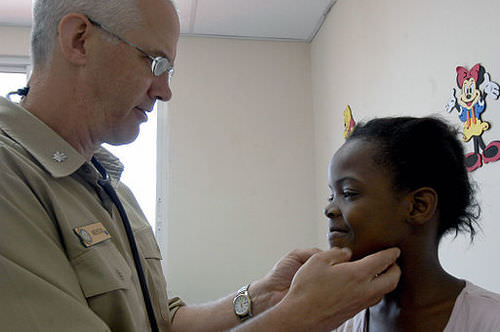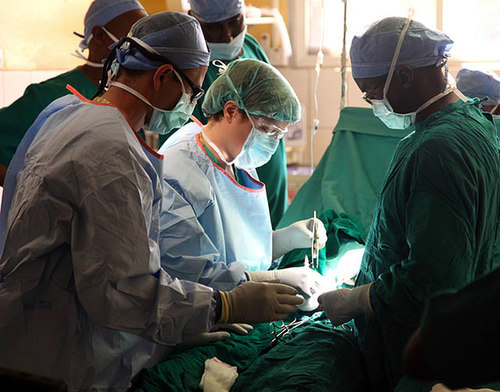19.1 案例研究:你的防御系统
章节大纲
-
Case Study: Defending Your Defenses
::案例研究:捍卫国防Twenty-six-year-old Brian wasn’t feeling well. He was more tired than usual, dragging through his workdays despite going to bed earlier, and napping on the weekends. He didn’t have much of an appetite, and had started losing weight. When he pressed on the side of his neck, like the doctor is doing in the photograph above, he noticed an unusual lump.
::26岁的Brian感觉不舒服。 他比平时更疲惫,在工作日里拖累,尽管早点睡觉,在周末打盹。 他没有多少胃口,开始减肥。 当他按着脖子的侧面时,就像医生在上面的照片中所做的那样,他注意到一个不寻常的肿块。Brian went to his doctor, who performed a physical exam and determined that the lump was a swollen lymph node. Lymph nodes are part of the immune system, and they will often become enlarged when the body is fighting off an infection. Dr. Hayes thinks that the swollen lymph node and fatigue could be signs of a viral or bacterial infection, although he is concerned about Brian’s lack of appetite and weight loss. All of those symptoms combined can indicate a type of cancer called lymphoma. A n infection, however, is a more likely cause, particularly in a young person like Brian. Dr. Hayes prescribes an antibiotic in case Brian has a bacterial infection, and advises him to return in a few weeks if his lymph node does not shrink, or if he is not feeling better.
::布莱恩去看了医生,他做了一次身体检查,并且确定肿块是一个肿胀的淋巴结。 淋巴结是免疫系统的一部分,当身体与感染抗争时,这些结节往往会扩大。 海斯医生认为肿胀的淋巴结和疲劳可能是病毒或细菌感染的症状,尽管他担心布莱恩缺乏食欲和体重损失。 所有这些症状合在一起可以表明一种叫淋巴结的癌症。 但是,感染是更可能的原因,特别是在像布莱恩这样的年轻人身上。 海斯医生规定了抗生素,以防布莱恩有细菌感染,并且建议他几周后返回,如果淋巴结不萎缩,或者他感觉不好的话。Brian returns a few weeks later. He is not feeling better and his lymph node is still enlarged. Dr. Hayes is concerned, and orders a biopsy of the enlarged lymph node. A lymph node biopsy for suspected lymphoma often involves the surgical removal of all or part of a lymph node. This helps to determine whether the tissue contains cancerous cells.
::Brian几周后返回。他身体不舒服,淋巴结仍然在扩大。Hayes博士很担心,并下令进行扩大淋巴结的活体切片。淋巴结对疑似淋巴结的活体切片往往需要外科切除淋巴结的全部或部分。这有助于确定组织是否含有癌症细胞。Surgeons performing a lymph node biopsy
::进行淋巴结结活性检查的外科医生The initial results of the biopsy indicate that Brian does have lymphoma. Although lymphoma is more common in older people, young adults and even children can get this disease. There are many types of lymphoma, with the two main types being Hodgkin and non-Hodgkin lymphoma. Non-Hodgkin lymphoma (NHL), in turn, has many subtypes. The subtype depends on several factors, including which cell types are affected. S ome subtypes of NHL, for example, affect immune system cells called B cells, while others affect different immune system cells called T cells.
::虽然淋巴瘤在老年人中更为常见,但年轻人甚至儿童也可能患上这种疾病。有多种淋巴瘤,其中两种主要类型是Hodgkin和Hodgkin以外的淋巴瘤。非Hodgkin淋巴瘤(NHL)反过来又有许多次型。亚型取决于若干因素,包括哪些细胞类型受到影响。例如,NHL的子型影响称为B细胞的免疫系统细胞,而其他则影响称为T细胞的不同免疫系统细胞。Dr. Hayes explains to Brian that it is important to determine which type of lymphoma he has, in order to choose the best course of treatment. Brian’s biopsied tissue will be further examined and tested to see which cell types are affected, as well as which specific cell-surface proteins — called antigens — are present. This should help identify his specific type of lymphoma.
::Hayes博士向Brian解释说,为了选择最好的治疗方法,必须确定他有哪类淋巴瘤。 将进一步检查和测试Brian的活性组织,以确定哪些细胞类型受到影响,以及存在哪些具体的细胞表层蛋白 — — 被称为抗原 — — 这应该有助于确定他特有的淋巴瘤类型。As you read this chapter, you will learn about the functions of the immune system, and the specific roles that its cells and organs — such as B and T cells and lymph nodes — play in defending the body. At the end of this chapter, you will learn what type of lymphoma Brian has and what some of his treatment options are, including treatments that make use of the biochemistry of the immune system to fight cancer with the immune system itself.
::阅读本章,你会了解免疫系统的功能,以及其细胞和器官——如B、T细胞和淋巴结——在捍卫身体方面的具体作用。在本章结尾,你会知道什么是淋巴瘤,布莱恩有什么样的治疗选择,包括利用免疫系统生物化学治疗免疫系统本身与癌症作斗争的治疗。Chapter Overview: Immune System
::章节概览:免疫系统In this chapter, you will learn about the immune system — the system that defends the body against infections and other causes of disease, such as cancerous cells. Specifically, you will learn about:
::在本章中,你们将了解免疫系统——保护身体免受感染和其他疾病原因,例如癌症细胞的感染和其他病因的系统。-
How the immune system identifies normal cells of the body as “self” and pathogens and damaged cells as “non-self”
::免疫系统如何将身体的正常细胞确定为“自我”和病原体,将受损细胞确定为“非自我” -
The two major subsystems of the general immune system: the innate immune system — which provides a quick, but non-specific response — and the adaptive immune system, which is slower, but provides a specific response that often results in long-lasting immunity
::普通免疫系统的两个主要子系统:内生免疫系统——它提供快速但非特定的反应——和适应性免疫系统,它较慢,但提供具体的反应,往往导致长期豁免。 -
The specialized immune system that protects the brain and spinal cord, called the neuroimmune system
::保护大脑和脊髓的专门免疫系统 叫做神经免疫系统 -
The organs, cells, and responses of the innate immune system, which includes physical barriers (such as skin and mucus), chemical and biological barriers, inflammation, activation of the complement system of molecules, and non-specific cellular responses (such as phagocytosis)
::内生免疫系统的器官、细胞和反应,包括物理屏障(如皮肤和粘结)、化学和生物屏障、发炎、分子补充系统激活和非特定细胞反应(如发细胞病) -
The lymphatic system — which includes white blood cells called lymphocytes, lymphatic vessels (which transport a fluid called lymph), and organs (such as the spleen, tonsils, and lymph nodes) — and its important role in the adaptive immune system
::淋巴系统——包括称为淋巴细胞的白血细胞、淋巴血管(运载一种称为淋巴体的液体)和器官(如脾脏、和淋巴结)——及其在适应性免疫系统中的重要作用。 -
Specific cells of the immune system and their functions, including B cells, T cells, plasma cells, and natural killer cells
::免疫系统具体细胞及其功能,包括B细胞、T细胞、血浆细胞和自然杀手细胞 -
How the adaptive immune system can generate specific and often long-lasting immunity against pathogens through the production of antibodies
::适应性免疫系统如何通过生产抗体,产生具体和往往是长期的抗病原体免疫力 -
How vaccines work to generate immunity
::疫苗如何产生免疫力 -
How cells in the immune system detect and kill cancerous cells
::免疫系统中细胞如何检测和杀死癌症细胞 -
Some strategies that pathogens employ to evade the immune system
::病原体用来逃避免疫系统的一些战略 -
Disorders of the immune system, including allergies, autoimmune diseases (such as diabetes and multiple sclerosis), and immunodeficiency resulting from conditions such as HIV infection
::免疫系统紊乱,包括过敏、自动免疫疾病(如糖尿病和多发性硬化症)和艾滋病毒感染等疾病引起的免疫机能丧失
As you read the chapter, think about the following questions:
::当你读到该章时,请考虑以下问题:1. What are the functions of lymph nodes?
::1. 淋巴结的功能是什么?2. What are B and T cells? How do they relate to lymph nodes?
::2. B和T细胞是什么?它们与淋巴结有何关系?3. What are cell-surface antigens? How do they relate to the immune system and to cancer?
::3. 什么是细胞表面抗原?它们与免疫系统和癌症有何关系? -
How the immune system identifies normal cells of the body as “self” and pathogens and damaged cells as “non-self”

